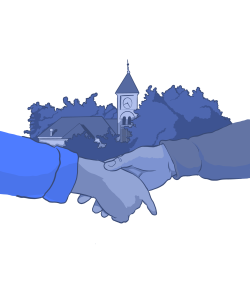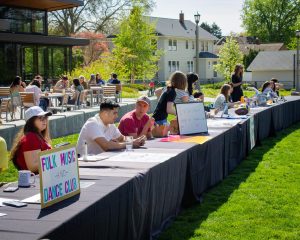In the foreword to “Where the Great River Bends,” a new book about the natural history of the Wallula Gap, senior lecturer of environmental humanities Don Snow writes, “The West is so full of dramatic landscapes and massive vistas that we who live here often take them for granted.” Commuters travelling through the Wallula Gap: a large water gorge which runs south of the merging of the Walla Walla and Columbia rivers: often miss its natural beauty, according to Snow.
Instead of bringing people to the Gap (although a field-trip on Thursday, Nov. 20 to promote the book was organized), the army of authors and photographers behind “Where the Great River Bends” brought the Gap to people.
The book highlights the Wallula Gap through a variety of black-and-white and color photographs, covering everything from its formation to the impact of climate change and damming on the area. The book also pays special attention to the Twin Sisters, a leftover formation from the floods during the end of the last ice age.
Most of the impetus behind the book rested on the shoulders of Bob Carson, professor of geology and environmental studies at Whitman.
In 2003, Carson went on sabbatical and decided to write a book about the Wallula Gap because he found the area “so special and so unique in terms of its geology and biology”. As the bottleneck of the Missoula Floods going from Montana into the Pacific Ocean, Carson likes to take his geology and environmental studies majors on field-trips to the Gap to observe its “depositional features.” The small details of the area are often pointed out to students, such as the beaver dam that resides in Juniper Canyon.
Carson was not alone in the creation of the book. Carson asked Michael “Mike” Denny, a riparian habitat coordinator at the Walla Walla County Conservation District, to write about the biology of the Wallula Gap.
But it became apparent that more content was needed. There was more to tell about the Wallula Gap.
“I asked Mike Denny to write about the biology, but then we decided to write about the archaeology and history so we got three experts,” said Carson, “and I can guarantee you that the people that wrote the archaeology, history and biology sections are the experts.”
One of the historians was Lawrence “Larry” Dodd, a former Whitman College archivist (Dodd retired in 2003). Dodd, a native of the Walla Walla Valley, chuckled at the thought of being published in the book. “Well, I guess it feels kind of nice,” he said.
Dodd wrote the history on the Wallula Gap from the “turn-of-the-century” to the time the McNary Dam on the Columbia River was finished in 1954. He was assisted by retired Whitman history professor Tom Edwards, who contributed the nineteenth century history section of the Wallula Gap.
Other contributors included archaeologist Catherine Dickson, and photographers Kathryn “Kathy” Guizar, Paul and John Clement, Robert Stockton and Dianne Kornberg.
Aside from creating a communal narrative for the Wallula Gap, “Bends” also acts as a cautionary tale for the preservation of the area.
As outlined by Carson, some of the problems that the Gap faces today are global climate change, pollution, and the decline in fish populations. But he is particularly critical of a proposed coal-fired power plant, which would cause “pollution there and in the Walla Walla Valley,” and a proposed dam in the Juniper Canyon area, which would “ruin that little oasis in the desert there.”
Carson is especially focused on the Twin Sisters. Since the 1920s, the geological feature has been famous for its rock climbing; but in the spring of 2001, Walla Walla County commissioners banned the activity.
“I taught my kids to rock climb there,” said Carson in a speech made on Wednesday, Nov. 19 to the Blue Mountain Audubon Society. “We’ve done silly things like sleep on top of one of the Twin Sisters. The county commissioners in the early part of this decade banned rock climbing at Wallula despite the fact that the Army Corps of Engineers gave [approval to the activity] for the specific reason of nature study, bird-watching, recreation and rock climbing.”
It’s the memories of the Wallula Gap that make the area important to Carson and the other contributors of “Where the Great River Bends,” and the hope is that book will inspire those drivers who travel through will pull to the side of the road and give themselves a little taste of the Gap before moving on.









